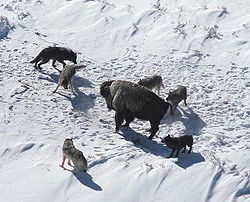Koinophilia
Koinophilia is an evolutionary hypothesis proposing that during sexual selection, animals preferentially seek mates with a minimum of unusual or mutant features, including functionality, appearance and behavior.
A koinophilic choice ensures that offspring are likely to inherit a suite of features and attributes that have served all the members of the species well in the past.
[7][24] This is the "horizontal" dimension of a two-dimensional problem,[28][29] referring to the almost complete absence of transitional or intermediate forms between present-day species (e.g. between lions, leopards, and cheetahs).
Fossil species are frequently remarkably stable over extremely long periods of geological time, despite continental drift, major climate changes, and mass extinctions.
Thus the fossil record suggests that evolution occurs in bursts, interspersed by long periods of evolutionary stagnation in so-called punctuated equilibria.
[23][34][35] Koinophilia could explain both the horizontal and vertical manifestations of speciation, and why it, as a general rule, involves the entire external appearance of the animals concerned.
Koinophilia will thereafter defend that species' appearance and behavior against invasion by unusual or unfamiliar forms (which might arise by immigration or mutation), and thus be a paradigm of punctuated equilibria (or the "vertical" aspect of the speciation problem).
[3][4] Evolution can be extremely rapid, as shown by the creation of domesticated animals and plants in a very short period of geological time, spanning only a few tens of thousands of years, by humans with little or no knowledge of genetics.
Thus, the capability to evolve is a group adaptation, which has been discredited by, among others, George C. Williams,[41] John Maynard Smith[42] and Richard Dawkins.
[4] Darwin emphasized that the shared biologically useless oddities and incongruities that characterize a species are signs of an evolutionary history – something that would not be expected if a bird's wing, for instance, was engineered de novo, as argued by his detractors.
[54] The present model predicts that, in addition to vestiges which reflect an organism's evolutionary heritage, all the members of a given species will also bear the stamp of their isolationary past – arbitrary, random features, accumulated through founder effects, genetic drift and the other genetic consequences of sexual reproduction in small, isolated communities.
[4][55] Thus all lions, African and Asian, have a highly characteristic black tuft of fur at the end of their tails, which is difficult to explain in terms of an adaptation, or as a vestige from an early feline, or more ancient ancestor.
The unique, often color- and pattern-rich plumage of each of today's wide variety of bird species presents a similar evolutionary enigma.
This richly varied array of phenotypes is more easily explained as the products of isolates, subsequently defended by koinophilia, than as assemblies of very diverse evolutionary relics, or as sets of uniquely evolved adaptations.
[47][61] Jelmer W. Poelstra and coworkers sequenced almost the entire genomes of both species in populations at varying distances from the contact zone to find that the two species were genetically identical, both in their DNA and in its expression (in the form of RNA), except for the lack of expression of a small portion (<0.28%) of the genome (situated on avian chromosome 18) in the hooded crow, which imparts the lighter plumage coloration on its torso.
[47][61] The authors attribute this to assortative mating, the advantage of which is not clear, and it would lead to the rapid appearance of streams of new lineages, and possibly even species, through mutual attraction between mutants.
William B. Miller,[5] in an extensive recent (2013) review of koinophilia theory, notes that while it provides precise explanations for the grouping of sexual animals into species, their unchanging persistence in the fossil record over long periods of time, and the phenotypic gaps between species, both fossil and extant, it represents a major departure from the widely accepted view that beneficial mutations spread, ultimately, to the whole, or some portion of the population (causing it to evolve gene by gene).
It is furthermore difficult to see how koinophilia might apply to plants, and certain marine creatures that discharge their gametes into the environment to meet up and fuse, it seems, entirely randomly (within conspecific confines).
[68] Marshall and Diggle state that the existence of some kind of non-random seed paternity is, in fact, not in question in flowering plants.
[69] The apparent preference of the females of certain, particularly bird, species for exaggerated male ornaments, such as the peacock's tail,[7][70][71] is not easily reconciled with the concept of koinophilia.







